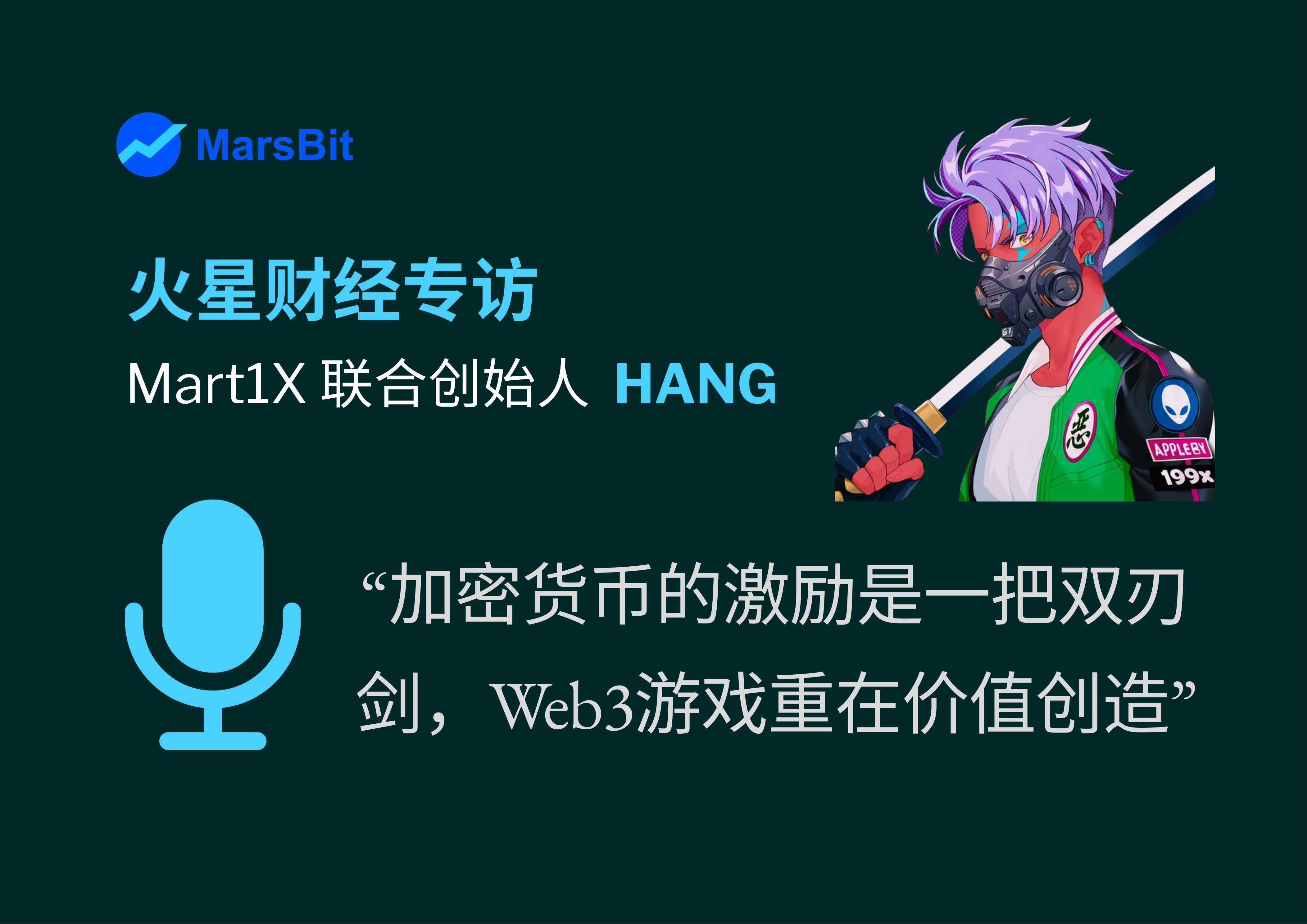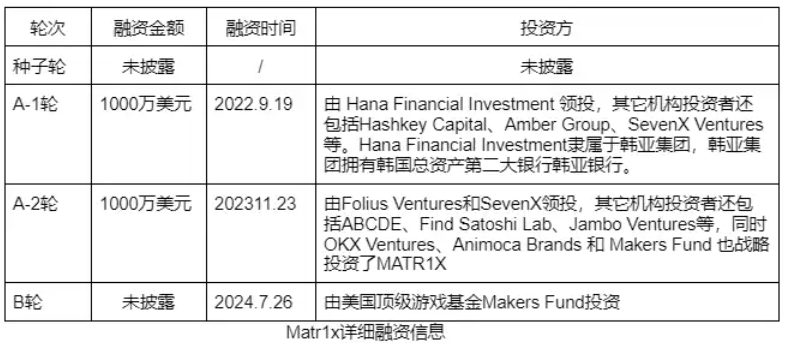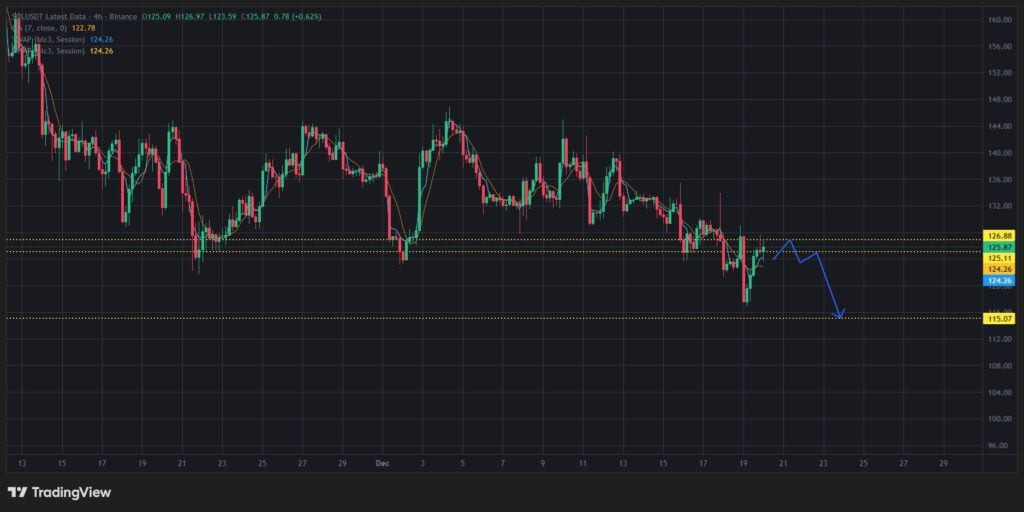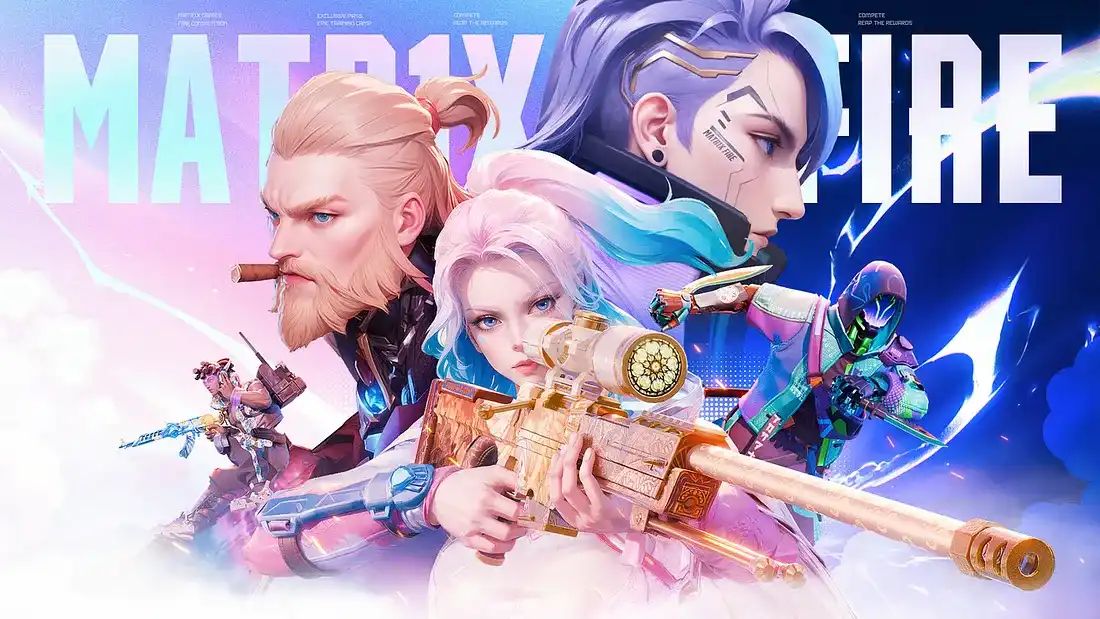Mars Finance Exclusive Interview | Shooting Game King Mart1X: How Will $20 Million in Financing Innovate Web3 Gaming?
Matr1x is an innovative Web3 gaming platform that integrates gaming, artificial intelligence, e-sports, and blockchain technology, aiming to reshape the global gaming and digital content industries. The team has extensive experience in game development and has secured over 20 million USD in funding. Matr1x has launched several Web3 games and e-sports platforms, demonstrating its innovation in tokenomics and ecosystem development. Through models such as "Watch to Earn," Matr1x is committed to promoting high-quality development of Web3 games and has established a significant presence in the market.

The Web3 gaming sector, after nearly two years of dormancy, is gradually approaching a turning point of recovery. One particularly noteworthy project in this space is Matr1x. As an innovative cultural entertainment platform that integrates Web3 gaming, artificial intelligence, e-sports, and blockchain infrastructure, Matr1x is committed to reshaping the global gaming and digital content industries through technological transformation, accelerating the arrival of the Web3 era.
The core team of Matr1x has accumulated over a decade of experience in game development and possesses atop-tier Web2 FPS game development background as well as large-scale product operation capabilities. Since its launch, the project has secured over $20 million in funding, with the most recent round coming from thetop North American fund Makers Fund, highlighting its strong market appeal and future potential. The architecture of Matr1x has gradually matured, with a portfolio offour native Web3 games, including the classic shooting mobile game MATR1X FIRE, which has over 2.5 million global downloads, its e-sports platform GEDA, and the OP-stack-based gaming public chain M1-Chain.
As Web3 games gradually transition from the “P2E” model to higher quality and playability, Matr1x’s positioning has undoubtedly earned it a place in this fiercely competitive track. Not only has it demonstrated the ability to create blockbuster Web3 games through self-developed products, but it has also shown a strong ecosystem layout in tokenomics. Matr1x’s governance token MAX was not publicly raised, but instead empowers users through ecosystem treasury allocation, Launchpool participation, airdrops, and other means, highlighting the project’s focus on long-term development.
Today, Matr1x’s team and technological accumulation have led many to consider it a strong contender to become the next Ronin or Immutable. Its unique operational model, blockbuster strategy, and deep incubation capabilities also add more imagination to the future of Web3 gaming.
Today, we at MarsBit are honored to invite Matr1x’s CO-FOUNDER HANG to unveil the innovative story behind this game.
MarsBit: Hello, first of all, it’s a great honor to have this conversation with you. Matr1x is a very interesting project. Could you briefly introduce your background to our readers? Including your educational background, experience in the Web3 field, and what motivated you to enter this sector?
HANG: Most of our founding team comes from Tencent, and we are quite familiar with both the gaming and blockchain fields. Every member of our founding team is very passionate about Web3, and we personally entered this industry quite early. The popularity of Axie in 2021 made us see the possibilities of games in Web3. We believe that years from now, Web3 games will also be high-quality games, gradually finding a balance between financial and gaming attributes.
MarsBit: An excellent team is the key to every successful project. The core members of your team have worked together for over a decade. How has this background helped the project gain advantages in R&D and operations? Could you share some interesting stories from the team formation process?
HANG: The team formation was actually very simple. As mentioned above,we all have Tencent backgrounds and are extremely interested in Web3. Among us, some are game industry professionals, some are blockchain practitioners, and some are from finance, so our team was quite complete from the start, with relatively few shortcomings. Our mutual understanding also meant lower friction, so from day one, we quickly got into the groove, and both product and operations made progress in a short time.
MarsBit: You have rich experience in developing Web2 games. How have these experiences inspired your innovation in the Web3 gaming field? Were there any key challenges or insights that made you rethink how to build a truly successful Web3 game?
HANG: To make a Web3 game, it must first be a game. For us,we have always believed that Web3 gaming needs a benchmark. Once this benchmark appears, a large number of excellent traditional teams will enter the Web3 gaming industry. But so far, this benchmark has not yet emerged.So what should this benchmark product be like? We believe it needs to meet the following criteria:
1. Phenomenal popularity and DAU (higher active users than conventional Web3 products)
2. Good gameplay and playability;
3. A business model and numerical design that provide a foundation for long-term operation (so far, all Web3 games have struggled to survive or operate for more than a year, essentially because they lack a sustainable foundation)
Meeting these criteria requires a highly experienced game team, and only a team with a strong Web3 sense can achieve this. Our professional experience tells us that a sustainable product must be logically self-consistent. If your product is not truly needed by gamers, it will only be a fleeting flash in the pan. Understanding these principles is what will allow Web3 to truly industrialize, rather than just being a passing fad.
In short, we look forward to the early emergence of such a benchmark, and we hope to be the one to set it.
MarsBit: Since Matr1x’s launch, the project has undergone nearly four rounds of financing and received support from top gaming strategic investors like Makers Fund. Could you share how the team balances growth and capital during fundraising? How much did Makers Fund invest in this round, and what strategic support did they provide? What major impact will this investment have on future development?

HANG: Overall, our fundraising follows a general rhythm. At every key milestone, we hope to have further capital support.Makers Fund serves as a strong endorsement for us in high-level regions such as Europe and the US, and even in the traditional gaming industry. Besides funding, they also support us in expanding into new markets. The new funds are similarly used for product development and market expansion.
MarsBit: On September 21, Matr1x launched its non-wipe gold farming test, allowing genesis character players to participate in gold mining and produce FIRE. Both NFT gold farming characters and the $FIRE price surged, especially as studios flocked in, intensifying the supply-demand imbalance. According to Bybit data, FIRE (MATR1X FIRE) broke through 1.97 USDT, setting a new all-time high. In this dual-spiral upward trend, how does Matr1x balance the scarcity of NFT characters and the consumption mechanism of $FIRE tokens? What is your view on the current $FIRE token hitting new highs, and are there plans to introduce more application scenarios to maintain the long-term value of $FIRE?
HANG:FIRE is actually different from many other game tokens. First, its total supply is capped, and with consumption in certain scenarios, it is continuously deflationary, which is very different from previous ever-inflating game tokens. Second, FIRE’s use cases are more diverse and may even be used across multiple games. When a game’s DAU remains at a large base, these tokens will become extremely scarce, and FIRE’s output will decrease over time. At that point, players will be rewarded with boxes and weapons, which are highly sought after and worth paying for by gamers.
MarsBit: Matr1x has successfully listed $MAX on several well-known exchanges and showcased its application scenarios in community governance, ecosystem capture, and staking rewards. As the platform ecosystem expands and more games join, $MAX will undoubtedly play a bigger role in the future. We noticed that $MAX’s empowerment is not limited to the FIRE game, but covers the entire Matr1x platform ecosystem. In the future, does Matr1x plan to further expand $MAX’s application scenarios, and how will you ensure the long-term value and sustained market demand for $MAX? Are there plans to list on other exchanges such as Bybit or Binance?
HANG:$MAX captures the value of the entire platform, and in the future, there will be a continuous stream of games joining the platform. Holding and staking $MAX will allow users to enjoy the platform’s overall revenue. As you know, we have several major games in development. As for listing on more exchanges, we are also actively pushing forward.
MarsBit: In the e-sports sector, Matr1x has not only established a unique brand image through its own teams and global e-sports competitions, but also innovatively proposed the “Watch to Earn” model to incentivize audience participation. As one of the pioneers, could you share in detail the specific mechanism of the “Watch to Earn” model and how it integrates with tokenomics? Under this model, how do you balance users’ long-term participation incentives with the platform’s economic sustainability? Does Matr1x plan to further expand its e-sports segment, such as collaborating with other Web3 ecosystem projects or traditional e-sports companies?
HANG:“Watch to Earn” was our first proposed slogan. We know that in the gaming field, everyone is extremely passionate about e-sports. Many players watch e-sports competitions. In Web3 games, we can use Web3 features to reward users, attract more community members to develop e-sports habits, and also attract and convert more traditional players. In fact, when more people participate in and learn about a high-quality game and e-sports, a positive effect is created. Real gamers are willing to pay and play long-term, gradually forming a sustainable model.
As for e-sports cooperation, we are very open. I hope to grow the industry together, so we are very willing to cooperate with other projects and high-quality traditional e-sports companies.
MarsBit: The Matr1x ecosystem public chain M1-Chain has been developed, based on the OP-Stack-ZK architecture, and has launched multiple games and e-sports events, attracting a large number of players worldwide. In the Web3 space, many public chains and gaming ecosystems are competing for user and developer resources. How do you view M1-Chain’s competitive advantages among many public chains? At the same time, how do you plan to further promote M1-Chain as the preferred infrastructure for Web3 gaming through cooperation with other Web3 projects, game developers, and communities?
HANG: We have always believed thatas a gaming platform, the most important thing is traffic. Our current strategy is to stabilize DAU users through several high-quality benchmark games, just as Steam initially relied on a few flagship games to bring in traffic.Then we will expand the platform for use by more industry developers. The advantage of M1-Chain is very clear: it comes from high-quality real game users, avoiding the phenomenon of “on-chain ghost towns” that are common in the market, where only studios and bots are active and no real users.
MarsBit: In the current Web3 gaming market, many mini-games have successfully attracted users through token value, such as NOT, DOGS, and the upcoming Hamster on the Ton ecosystem. The market cap of these tokens even surpasses many large AAA games. How do you view the success of these mini-games? Does it reflect the market’s neglect of deep gaming experiences? Will the Matr1x platform also develop some casual mini-games in the future, and how will Matr1x balance the high investment of AAA titles with the rapid iteration of mini-games?
HANG: We believe thatgames are divided into mini-games and high-investment games, and neither is wrong. But the core is that the logic must ultimately be self-consistent. Whether it’s a big game or a mini-game, you need to figure out why people play games and whether it’s sustainable. Our product philosophy is still committed to creating joy for real gamers. We’ve seen many short-term hot projects in the industry, but running farther is more important than running faster.
MarsBit: In the Web3 gaming industry, many projects fall into an unsustainable “death spiral” due to over-reliance on short-term incentives. In response to this phenomenon, as an emerging gaming platform, how does Matr1x build its business model to ensure the sustainability of a game’s lifecycle? Specifically, what innovative strategies has the team adopted in game design, user retention, and community building? At the same time, how do you balance revenue and user experience in fierce market competition to attract and retain a large number of real users, thereby achieving long-term ecological health?
HANG:This is a very good point,and it’s also the one we value most: value creation. Web3 incentives are a double-edged sword. If not used well, problems can easily arise. We often see many projects lose momentum after distributing rewards, with hype, community, and discussion fading away, and eventually being forgotten. The root cause is that these products are not needed. The world’s best companies make good products and find the people who need them. Doing these two things well enables long-term sustainable development, and we have always been committed to this goal.
Crypto incentives are a double-edged sword; Web3 gaming is about value creation.
Indeed, as Hang said, after nearly two years of dormancy and reflection, the Web3 gaming industry has now reached a turning point. With bitcoin hitting new highs and the crypto industry once again in the spotlight, Web3 game Matr1x is rising like the dawn, becoming an important force in reshaping the global gaming and digital content industries. Matr1x not only demonstrates the possibilities of Web3 gaming’s future, but also brings new hope for the revival of the entire sector.
Disclaimer: The content of this article solely reflects the author's opinion and does not represent the platform in any capacity. This article is not intended to serve as a reference for making investment decisions.
You may also like
Best Crypto to Buy Now? Solana Price Prediction, New Crypto Coin

Stunning Prediction: Bitcoin All-Time High Could Arrive in 2025, Says Galaxy Digital
XRP Daily Bollinger Bands Signal Grim Outlook: Why $2 is a Distant Dream This Year
Smart Investors Bargain Hunt for Altcoins Now: Arthur Hayes Reveals Why

